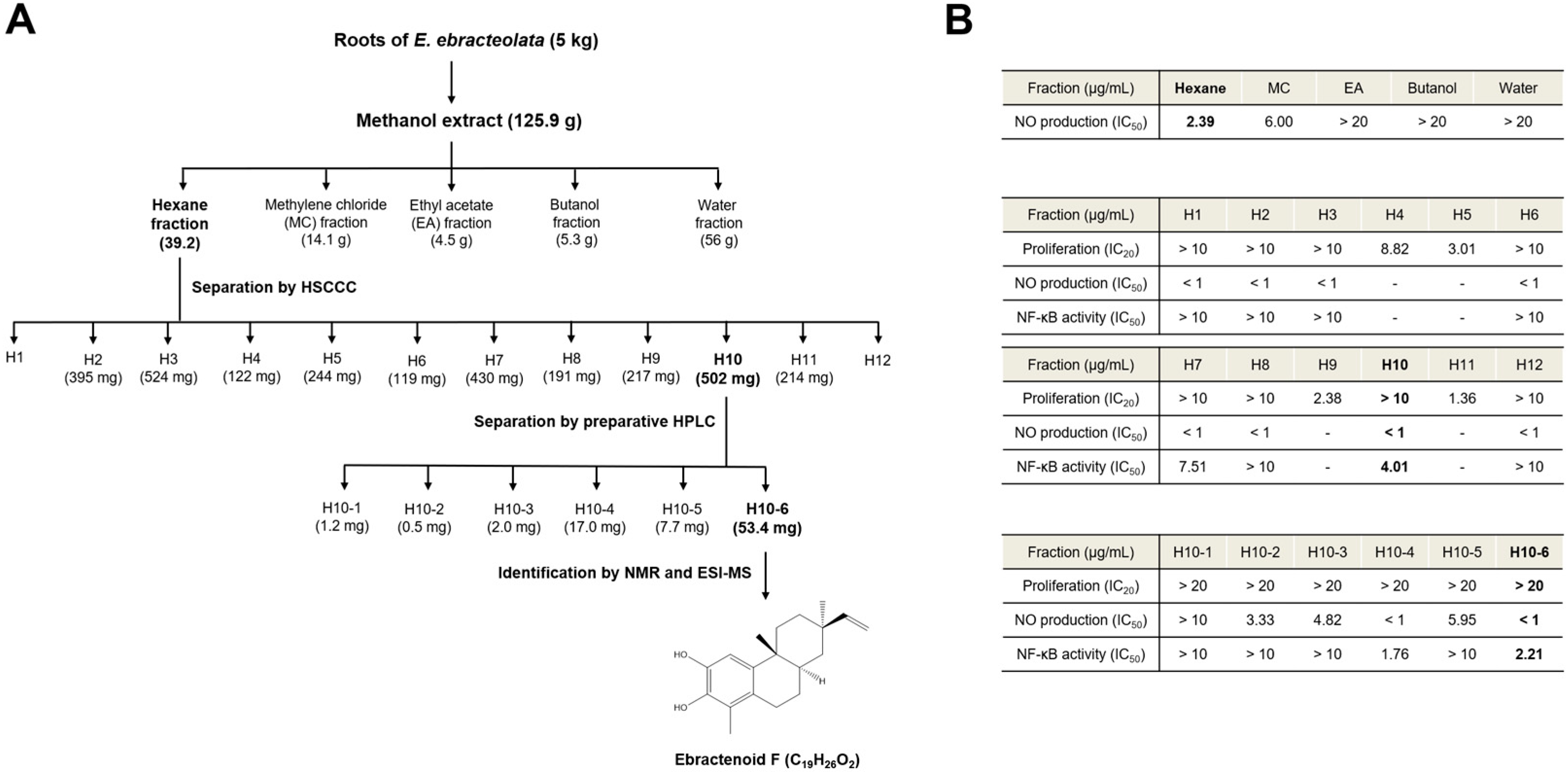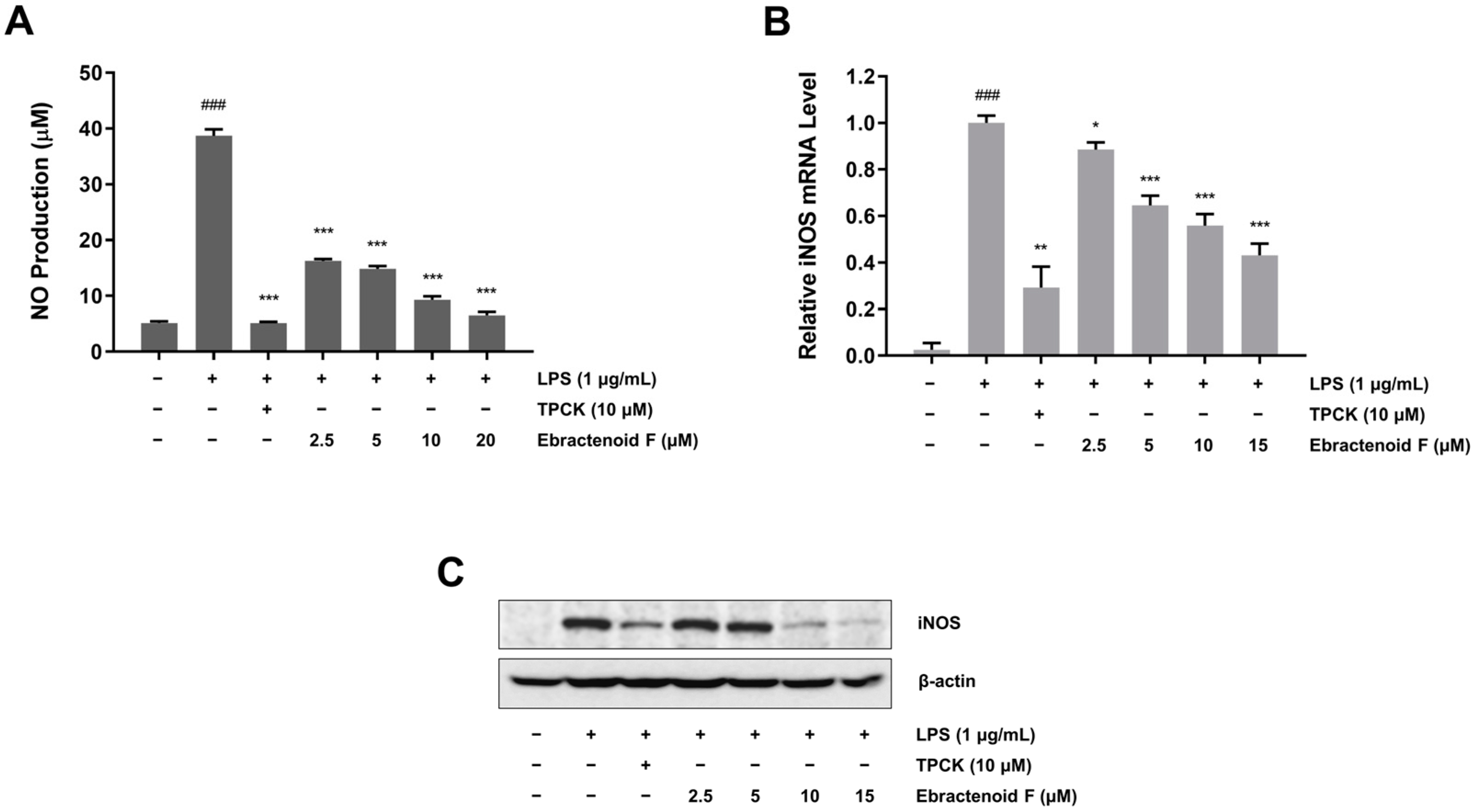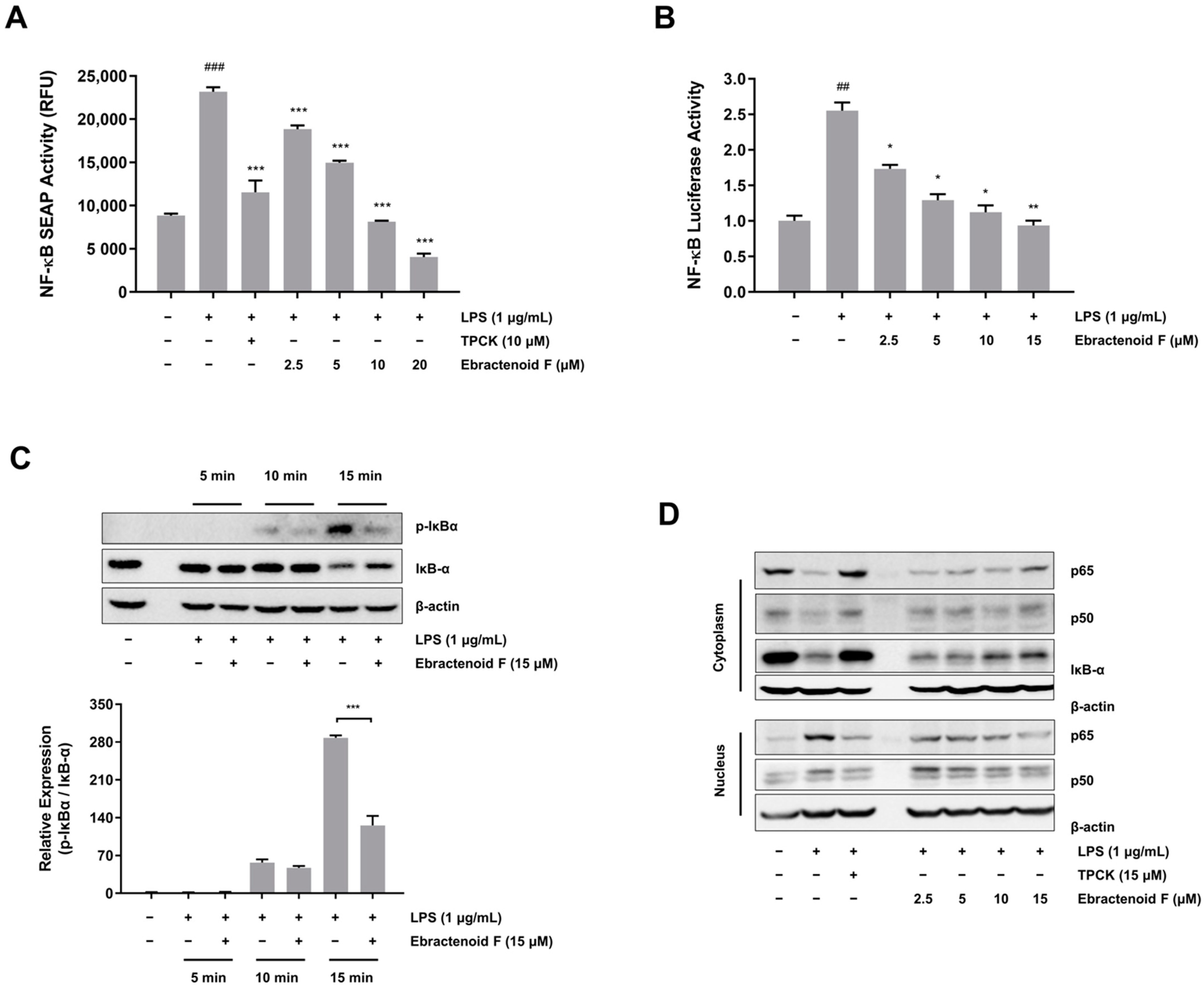Anti-Inflammatory Effect of Ebractenoid F, a Major Active Compound of Euphorbia ebracteolata Hayata, through Inhibition of Nuclear Factor-κB Activation
Abstract
1. Introduction
2. Results
2.1. Bioactive Screening of E. ebracteolata Hayata for Anti-Inflammatory Activity
2.2. Inhibitory Effect of Ebractenoid F on NO Production in LPS-Induced RAW 264.7 Cells
2.3. Inhibitory Effect of Ebractenoid F on LPS-Mediated NF-κB Transcriptional Activation in RAW 264.7 Cells
2.4. Inhibitory Effects of Ebractenoid F on the Inflammatory Mediators IL-6 and IL-1β
2.5. Inhibitory Effect of Ebractenoid F on Phosphorylation in the Mitogen-Activated Protein Kinase (MAPK) and Akt Pathways
3. Discussion
4. Materials and Methods
4.1. Materials and Reagents
4.2. Extraction and Isolation
4.3. HPLC Analysis
4.4. Identification of the Isolated Compound
4.5. Cell Culture
4.6. Cell Viability
4.7. Measurement of NO Production
4.8. NF-κB SEAP Assay
4.9. NF-κB Luciferase Assay
4.10. Western Blotting
4.11. qRT-PCR
4.12. Statistical Analysis
5. Conclusions
Supplementary Materials
Author Contributions
Funding
Data Availability Statement
Conflicts of Interest
References
- Lee, K.H.; Morris-Natschke, S.; Qian, K.; Dong, Y.; Yang, X.; Zhou, T.; Belding, E.; Wu, S.F.; Wada, K.; Akiyama, T. Recent progress of research on herbal products used in traditional Chinese medicine: The herbs belonging to the divine husbandman’s herbal foundation canon (Shén Nóng Běn Cǎo Jīng). J. Tradit. Complement. Med. 2012, 2, 6–26. [Google Scholar] [CrossRef] [PubMed]
- Liu, Z.G.; Li, Z.L.; Li, D.H.; Li, N.; Bai, J.; Zhao, F.; Meng, D.L.; Hua, H.M. ent-abietane-type diterpenoids from the roots of Euphorbia ebracteolata with their inhibitory activities on LPS-induced NO production in RAW 264.7 macrophages. Bioorg. Med. Chem. Lett. 2016, 26, 1–5. [Google Scholar] [CrossRef] [PubMed]
- Bai, J.; Huang, X.Y.; Liu, Z.G.; Gong, C.; Li, X.Y.; Li, D.H.; Hua, H.M.; Li, Z.L. Four new compounds from the roots of Euphorbia ebracteolata and their inhibitory effect on LPS-induced NO production. Fitoterapia 2018, 125, 235–239. [Google Scholar] [CrossRef] [PubMed]
- Liu, Z.G.; Li, Z.L.; Bai, J.; Meng, D.L.; Li, N.; Pei, Y.H.; Zhao, F.; Hua, H.M. Anti-inflammatory diterpenoids from the roots of Euphorbia ebracteolata. J. Nat. Prod. 2014, 77, 792–799. [Google Scholar] [CrossRef]
- Akdis, C.A. Does the epithelial barrier hypothesis explain the increase in allergy, autoimmunity and other chronic conditions? Nat. Rev. Immunol. 2021, 21, 739–751. [Google Scholar] [CrossRef]
- Pasparakis, M.; Vandenabeele, P. Necroptosis and its role in inflammation. Nature 2015, 517, 311–320. [Google Scholar] [CrossRef]
- Zhao, J.; Zhang, L.; Mu, X.; Doebelin, C.; Nguyen, W.; Wallace, C.; Reay, D.P.; McGowan, S.J.; Corbo, L.; Clemens, P.R.; et al. Development of novel NEMO-binding domain mimetics for inhibiting IKK/NF-κB activation. PLoS Biol. 2018, 16, 2004663. [Google Scholar] [CrossRef]
- Meier-Soelch, J.; Mayr-Buro, C.; Juli, J.; Leib, L.; Linne, U.; Dreute, J.; Papantonis, A.; Schmitz, M.L.; Kracht, M. Monitoring the levels of cellular NF-κB activation states. Cancers 2021, 13, 5351. [Google Scholar] [CrossRef]
- Weller, M.G. A unifying review of bioassay-guided fractionation, effect-directed analysis and related techniques. Sensors 2012, 12, 9181–9209. [Google Scholar] [CrossRef]
- Tirunavalli, S.K.; Gourishetti, K.; Kotipalli, R.S.S.; Kuncha, M.; Kathirvel, M.; Kaur, R.; Jerald, M.K.; Sistla, R.; Andugulapati, S.B. Dehydrozingerone ameliorates lipopolysaccharide induced acute respiratory distress syndrome by inhibiting cytokine storm, oxidative stress via modulating the MAPK/NF-κB pathway. Phytomedicine 2021, 92, 153729. [Google Scholar] [CrossRef]
- Hoesel, B.; Schmid, J.A. The complexity of NF-κB signaling in inflammation and cancer. Mol. Cancer 2013, 12, 86. [Google Scholar] [CrossRef]
- Xu, Z.H.; Qin, G.W.; Xu, R.S. An isopimarane diterpene from Euphorbia ebracteolata Hayata. J. Asian Nat. Prod. Res. 2000, 2, 257–261. [Google Scholar] [CrossRef]
- Xu, Z.H.; Sun, J.; Xu, R.S.; Qin, G.W. Casbane diterpenoids from Euphorbia ebracteolata fn2. Phytochemistry 1998, 49, 149–151. [Google Scholar] [CrossRef]
- Ansari, M.A.; Khan, F.B.; Safdari, H.A.; Almatroudi, A.; Alzohairy, M.A.; Safdari, M.; Amirizadeh, M.; Rehman, S.; Equbal, M.J.; Hoque, M. Prospective therapeutic potential of Tanshinone IIA: An updated overview. Pharmacol. Res. 2021, 164, 105364. [Google Scholar] [CrossRef] [PubMed]
- Loussouarn, M.; Krieger-Liszkay, A.; Svilar, L.; Bily, A.; Birtić, S.; Havaux, M. Carnosic acid and carnosol, two major antioxidants of rosemary, act through different mechanisms. Plant Physiol. 2017, 175, 1381–1394. [Google Scholar] [CrossRef] [PubMed]
- Song, K.; Lee, K.J.; Kim, Y.S. Development of an efficient fractionation method for the preparative separation of sesquiterpenoids from Tussilago farfara by counter-current chromatography. J. Chromatogr. A 2017, 1489, 107–114. [Google Scholar] [CrossRef] [PubMed]
- Liu, M.; Tao, L.; Chau, S.L.; Wu, R.; Zhang, H.; Yang, Y.; Yang, D.; Bian, Z.; Lu, A.; Han, Q.; et al. Folding fan mode counter-current chromatography offers fast blind screening for drug discovery. Case study: Finding anti-enterovirus 71 agents from Anemarrhena asphodeloides. J. Chromatogr. A 2014, 1368, 116–124. [Google Scholar] [CrossRef]
- Virág, L.; Jaén, R.I.; Regdon, Z.; Boscá, L.; Prieto, P. Self-defense of macrophages against oxidative injury: Fighting for their own survival. Redox Biol. 2019, 26, 101261. [Google Scholar] [CrossRef]
- Kolliniati, O.; Ieronymaki, E.; Vergadi, E.; Tsatsanis, C. Metabolic regulation of macrophage activation. J. Innate Immun. 2022, 14, 51–68. [Google Scholar] [CrossRef]
- Palmieri, E.M.; McGinity, C.; Wink, D.A.; McVicar, D.W. Nitric oxide in macrophage immunometabolism: Hiding in plain sight. Metabolites 2020, 10, 429. [Google Scholar] [CrossRef]
- Viatour, P.; Merville, M.P.; Bours, V.; Chariot, A. Phosphorylation of NF-κB and IκB proteins: Implications in cancer and inflammation. Trends Biochem. Sci. 2005, 30, 43–52. [Google Scholar] [CrossRef]
- Mantovani, A.; Allavena, P.; Sica, A.; Balkwill, F. Cancer-related inflammation. Nature 2008, 454, 436–444. [Google Scholar] [CrossRef] [PubMed]
- Serreli, G.; Deiana, M. Role of dietary polyphenols in the activity and expression of nitric oxide synthases: A review. Antioxidants 2023, 12, 147. [Google Scholar] [CrossRef] [PubMed]
- Seger, R.; Krebs, E.G. The MAPK signaling cascade. FASEB J. 1995, 9, 726–735. [Google Scholar] [CrossRef] [PubMed]
- Cicenas, J.; Zalyte, E.; Rimkus, A.; Dapkus, D.; Noreika, R.; Urbonavicius, S. JNK, p38, ERK, and SGK1 inhibitors in cancer. Cancers 2017, 10, 1. [Google Scholar] [CrossRef]
- Fang, Y.; Yang, L.; He, J. Plantanone C attenuates LPS-stimulated inflammation by inhibiting NF-κB/iNOS/COX-2/MAPKs/Akt pathways in RAW 264.7 macrophages. Biomed. Pharmacother. 2021, 143, 112104. [Google Scholar] [CrossRef]
- Lee, H.J.; Maeng, K.; Dang, H.T.; Kang, G.J.; Ryou, C.S.; Jung, J.H.; Kang, H.K.; Prchal, J.T.; Yoo, E.S.; Yoon, D. Anti-inflammatory effect of methyl dehydrojasmonate (J2) is mediated by the NF-κB pathway. J. Mol. Med. 2011, 89, 83–90. [Google Scholar] [CrossRef]
- Lee, Y.G.; Lee, J.; Byeon, S.E.; Yoo, D.S.; Kim, M.H.; Lee, S.Y.; Cho, J.Y. Functional role of Akt in macrophage-mediated innate immunity. Front. Biosci. Landmark Ed. 2011, 16, 517–530. [Google Scholar] [CrossRef]
- Chun, J.; Choi, R.J.; Khan, S.; Lee, D.S.; Kim, Y.C.; Nam, Y.J.; Lee, D.U.; Kim, Y.S. Alantolactone suppresses inducible nitric oxide synthase and cyclooxygenase-2 expression by down-regulating NF-κB, MAPK and AP-1 via the MyD88 signaling pathway in LPS-activated RAW 264.7 cells. Int. Immunopharmacol. 2012, 14, 375–383. [Google Scholar] [CrossRef]





| Position | δH (J in Hz) | δC |
|---|---|---|
| 1 | 6.7, s | 108.8 |
| 2 | - | 140.8 |
| 3 | - | 139.9 |
| 4 | - | 122.6 |
| 5 | - | 127.1 |
| 6 | 2.64, m | 26.9 |
| 7 | 1.55, m | 25.7 |
| 1.64, m | ||
| 8 | 1.64, m | 36.4 |
| 9 | - | 36.4 |
| 10 | - | 140.4 |
| 11 | 1.57, m | 34.1 |
| 1.95, m | ||
| 12 | 1.37, m | 32.9 |
| 1.66, m | ||
| 13 | - | 36.4 |
| 14 | 1.19, m | 39.6 |
| 1.44, m | ||
| 15 | 5.86, dd (17.4, 10.8) | 151.1 |
| 16 | 4.87, dd (10.8, 0.9) | 108.9 |
| 4.95, dd (17.4, 0.9) | ||
| 17 | 1.02, s | 22.8 |
| 18 | ||
| 19 | 2.11, s | 11.4 |
| 20 | 1.01, s | 21.3 |
Disclaimer/Publisher’s Note: The statements, opinions and data contained in all publications are solely those of the individual author(s) and contributor(s) and not of MDPI and/or the editor(s). MDPI and/or the editor(s) disclaim responsibility for any injury to people or property resulting from any ideas, methods, instructions or products referred to in the content. |
© 2023 by the authors. Licensee MDPI, Basel, Switzerland. This article is an open access article distributed under the terms and conditions of the Creative Commons Attribution (CC BY) license (https://creativecommons.org/licenses/by/4.0/).
Share and Cite
Chun, J.; Mah, S.Y.; Kim, Y.S. Anti-Inflammatory Effect of Ebractenoid F, a Major Active Compound of Euphorbia ebracteolata Hayata, through Inhibition of Nuclear Factor-κB Activation. Plants 2023, 12, 2845. https://doi.org/10.3390/plants12152845
Chun J, Mah SY, Kim YS. Anti-Inflammatory Effect of Ebractenoid F, a Major Active Compound of Euphorbia ebracteolata Hayata, through Inhibition of Nuclear Factor-κB Activation. Plants. 2023; 12(15):2845. https://doi.org/10.3390/plants12152845
Chicago/Turabian StyleChun, Jaemoo, Sang Yeon Mah, and Yeong Shik Kim. 2023. "Anti-Inflammatory Effect of Ebractenoid F, a Major Active Compound of Euphorbia ebracteolata Hayata, through Inhibition of Nuclear Factor-κB Activation" Plants 12, no. 15: 2845. https://doi.org/10.3390/plants12152845
APA StyleChun, J., Mah, S. Y., & Kim, Y. S. (2023). Anti-Inflammatory Effect of Ebractenoid F, a Major Active Compound of Euphorbia ebracteolata Hayata, through Inhibition of Nuclear Factor-κB Activation. Plants, 12(15), 2845. https://doi.org/10.3390/plants12152845







